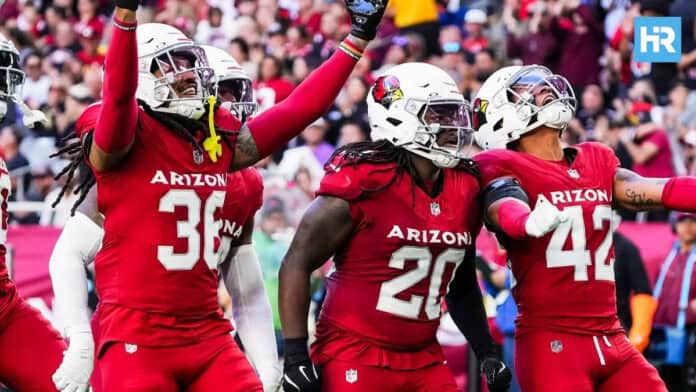The Arizona Cardinals have one of the longest and most interesting stories in football. They started way back in 1898 as a small team called the Morgan Athletic Club in Chicago, and today, they are known as the oldest professional football team still playing in the NFL.
Over the years, the Cardinals have moved from Chicago to St. Louis, and then to Arizona, where they still play today. Along the way, they have seen both good times and bad. They have won championships, suffered through long losing seasons, and built some unforgettable moments that fans still talk about.
From their first championship win in 1925 to a second one in 1947, to their exciting but heartbreaking trip to the Super Bowl in 2008, the Cardinals have shown the world what it means to keep fighting, no matter what. Even when things got tough, the team stayed strong, always looking for a way to get better.
Now, we’ll walk through the full history of the Arizona Cardinals — how they started, the famous players who wore the uniform, the moves they made, and the special moments that have helped them for who they are today. This is the story of a team that has been through it all but never gave up.
- The Arizona Cardinals are the oldest professional football team in the NFL, founded in 1898.
- They have moved cities twice, starting in Chicago, then to St. Louis, and finally to Arizona.
- Despite being one of the oldest teams, the Cardinals have won only two NFL championships (1925 and 1947) and have appeared in just one Super Bowl (2008).
The Birth of the Cardinals (1898–1920)
The Arizona Cardinals began in 1898 when Chris O’Brien formed a small team called the Morgan Athletic Club on the South Side of Chicago. At first, it was just a group of local athletes playing football together without any official league.
A few years later, O’Brien bought used football jerseys from the University of Chicago Maroons. The jerseys had faded from their original maroon color to a shade O’Brien described as “Cardinal red.” This name stuck, and it became part of the team’s identity.
As the team grew, they started playing their games on Racine Street in Chicago. Because of this, they became known as the Racine Street Cardinals. At the time, there was no organized national league, so the Cardinals competed against other amateur clubs in the Chicago area.
Joining the NFL and the Early Chicago Years (1920–1960)
In 1920, the Cardinals became one of the original teams to join the newly formed American Professional Football Association, the organization that would later change its name to the National Football League.
Right after joining, the Cardinals faced a challenge on their home turf. Another team in Chicago, the Chicago Tigers, also joined the league. To settle who would control the city, the Cardinals and Tigers agreed to a winner-take-all game. The Cardinals won a hard-fought 6-0 game, with the only touchdown scored by Paddy Driscoll, securing their right to stay.
In 1922, the team officially changed its name to the Chicago Cardinals. This was necessary because the league added a team from Racine, Wisconsin, and the Cardinals wanted to make sure their identity was clear.
Three years later, in 1925, the Cardinals reached their first major milestone. They finished the season with a record of 11 wins, 2 losses, and 1 tie, earning them their first NFL Championship. Even though the title involved some controversy with the Pottsville Maroons, the league awarded the championship to the Cardinals.
One of the most famous moments in early NFL history came in 1929 when Ernie Nevers scored all 40 points in a 40-6 victory over the Chicago Bears. His record for most points by a single player in a game still stands today.
In 1932, ownership of the team changed when Charles W. Bidwill bought the Cardinals. Bidwill kept the team going through the hard years of the Great Depression and World War II when many teams struggled just to survive.
After the war, Bidwill’s efforts to build a strong roster finally paid off. Under coach Jimmy Conzelman, the Cardinals put together a talented group known as the “Million-Dollar Backfield,” which included Charley Trippi, Paul Christman, Pat Harder, Marshall Goldberg, and Elmer Angsman. This team led the Cardinals to their second NFL Championship in 1947, beating the Philadelphia Eagles by a score of 28-21.
The Cardinals made it back to the title game again in 1948, but this time they lost to the Eagles, 7-0, in a game played in heavy snow.
After that, the team’s success faded. Through the late 1940s and 1950s, the Cardinals struggled to stay competitive, slipping back into years of losing seasons and shrinking fan support.
Moving to St. Louis (1960–1987)
By 1960, after 40 seasons in Chicago, the Cardinals were struggling with low attendance and financial problems. To try and save the team, ownership made the decision to relocate to St. Louis, Missouri.
In St. Louis, the team was usually called the “Football Cardinals” to avoid confusion with the city’s popular Major League Baseball team, the St. Louis Cardinals. Even with a fresh start in a new city, it wasn’t easy. The team had some competitive seasons but often came up short when it mattered most.
In 1964 and again in 1968, the Cardinals came close to reaching the playoffs but finished just half a game behind the Cleveland Browns both times. It wasn’t until 1974 that they finally broke through. With key players like quarterback Jim Hart, running back Terry Metcalf, offensive lineman Dan Dierdorf, and tight end Jackie Smith, the Cardinals won 10 games and captured the NFC Eastern Division title. They made it back to the playoffs the next season in 1975, winning the division again, but lost in the first round both years.
Even with a strong core of players and back-to-back division titles, the team couldn’t turn those successes into long-term dominance. Sustained playoff runs never materialized, and the excitement faded.
By the 1980s, the Cardinals were dealing with serious problems off the field, too. Fan support was weak, and the team was stuck playing in an old stadium that didn’t bring in enough money. Frustrated with the situation and looking for a better opportunity, owner Bill Bidwill decided it was time to move the franchise again.
The Cardinals’ Home: State Farm Stadium
The Cardinals moved into a new home in 2006 with the opening of the University of Phoenix Stadium in Glendale, Arizona. The facility replaced Sun Devil Stadium and gave the franchise a permanent, modern venue.
The stadium features a retractable roof and a roll-out Bermuda grass field that can adjust to both weather and playing conditions. It can hold up to 63,400 fans, and over the years, it has become a major venue for both the Cardinals and national events.
Since opening, the stadium — now called State Farm Stadium — has hosted multiple Super Bowls.
Legendary Cardinals Players and Records
Through more than a century of football, the Cardinals have had standout players set lasting records.
Ottis Anderson, who played for the team from 1979 to 1986, holds the record for most rushing yards in franchise history with 7,999 yards.
Jim Hart, the Cardinals’ long-time quarterback from 1966 to 1983, leads in career passing yards with 34,639.
No player made a bigger mark as a receiver than Larry Fitzgerald. From 2004 to 2020, Fitzgerald caught 1,432 passes, which makes him the team’s all-time leader in receptions and one of the greatest wide receivers in NFL history.
On defense, Chandler Jones recorded 71.5 sacks between 2016 and 2021, the most by any player in Cardinals history. Larry Wilson, who played from 1960 to 1972, still holds the franchise record with 52 career interceptions.
For scoring, Jim Bakken, the team’s kicker from 1962 to 1978, put up 1,380 total points, making him the Cardinals’ all-time leading scorer.
Beyond stats, several players stand out as defining figures in team history. Charley Trippi, a Hall of Famer from the 1947 championship team, helped lead the famed “Million-Dollar Backfield.” Paddy Driscoll, who starred in the 1920s, played a major role in establishing the team during its early NFL years. In more recent history, quarterbacks like Kurt Warner, who led the 2008 Super Bowl run, and Jake Plummer, who helped snap a decades-long playoff drought in 1998.
Ownership and Leadership Legacy
The Cardinals’ story begins with Chris O’Brien, who founded the team in 1898 as the Morgan Athletic Club. He ran the club through its earliest years and gave it the name “Cardinals” after acquiring used red jerseys.
In 1932, the team was bought by Charles W. Bidwill, beginning a long stretch of family ownership. Bidwill was responsible for building the team that won the 1947 NFL Championship, although he died before seeing it happen.
His son, William V. Bidwill, later took over and remained in control through the team’s moves from Chicago to St. Louis, and eventually to Arizona in 1988.
Today, the Cardinals are owned by Michael Bidwill, William’s son. Under his leadership, the team has continued to invest in players, facilities, and long-term growth — even as they work through the challenges of building a consistent winning culture.
The Cardinals Today and the Road Ahead
The Cardinals are now part of a much larger market than when they first arrived in Arizona. As of 2022, the population of Phoenix has grown to more than 1.6 million, one of the largest cities in the country.
Still, the team faces serious challenges. After back-to-back 4–13 seasons in 2022 and 2023, the Cardinals are once again trying to rebuild. Questions remain about coaching, player development, and how to get back to being a playoff team.
The Cardinals’ history is full of setbacks, but also of perseverance. Through more than a century of changes, the team has never stopped showing up. That, more than anything, defines what this franchise is — not as the oldest team in the NFL, but one that keeps moving forward, no matter how tough the road gets.






